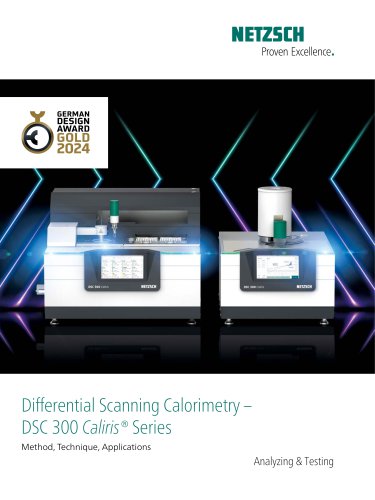 Website:
NETZSCH Analyzing & Testing
Website:
NETZSCH Analyzing & Testing
Group: NETZSCH
Catalog excerpts

Proven Excellence. Accelerating Rate Calorimetry Advanced Solution for Chemical Process Safety, Energetic Material, and Battery Development Analyzing & Testing
Open the catalog to page 1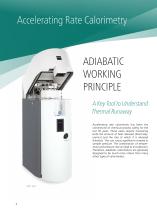
Accelerating Rate Calorimetry ADIABATIC WORKING PRINCIPLE Key Tool to Understand A Thermal Runaway Accelerating rate calorimetry has been the cornerstone of chemical process safety for the last 30 years. More recently, adiabatic calorimetry has been widely used in measuring the potential of thermal runaway of Li-ion cells. These cases are similar in that they require measuring both the amount of heat released (thermodynamics) and the rate at which the heat is released (kinetics). In both cases, there can be a significant increase in sample pressure and the combination of the temperature and...
Open the catalog to page 2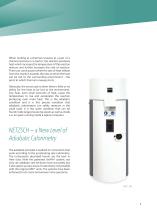
When looking at a thermal runaway as a part of a chemical process in a reactor, the reaction produces heat which increases the temperature of the reaction mixture and further increases the rate of reaction. There can come a point when the rate of heat release from the reaction exceeds the rate at which the heat can be lost to the surrounding environment – the point at which thermal runaway starts. Obviously, the worst case is when there is little or no ability for the heat to be lost to the environment. Any heat, even small amounts of heat, cause the temperature to rise and accelerates the...
Open the catalog to page 3
Sample Container The energy release from chemical reactions (decomposition, etc.) is a point of focus in chemical research and other industries. When energy is generated by a thermally induced chemical reaction and the heat transfer to the outside is smaller than the generated amount, runaway reactions can occur. In the worst case, this can cause catastrophic events (explosions). Adiabatic calorimeters are ideal tools for analyzing such scenarios as they simulate the worst case scenario with no heat exchange with the surroundings. The behavior in real large scale chemical reactors can...
Open the catalog to page 4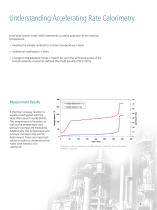
Understanding Accelerating Rate Calorimetry Heat-Wait-Search mode (HWS) represents a careful approach to the reaction temperature: Heating the sample material to a certain temperature → Heat Isothermal stabilization → Wait Change to the adiabatic mode → Search (as soon the self-heating rate of the sample extends a customer-defined threshold (usually 0.02 K/min)) Measurement Results A thermal runaway reaction is usually investigated with the Heat‐Wait‐Search mode (HWS). The temperature of reaction as well as the temperature and pressure increase are measured. Additionally, the temperature...
Open the catalog to page 5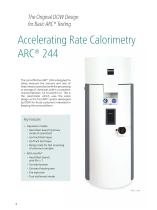
The Original DOW Design for Basic ARC® Testing The cost-effective ARC® 244 is designed to safely measure the amount and rate of heat release associated with the processing or storage of chemicals within a container volume between 1.5 ml and 8.5 ml. This is the calorimeter which uses the same design as the first ARC® system developed by DOW for those customers interested in keeping the same platform. Key Features • Operation modes: ■ Heat-Wait-Search (primary mode of operation) ■ Iso-Fixed technique ■ Iso-Track technique ■ Ramp mode for fast screening of unknown samples ■ With VariPhi® •...
Open the catalog to page 6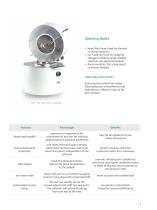
Operating Modes Heat-Wait-Search test for thermal runaway reactions Iso-Fixed/Iso-Track for studying storage conditions/auto-catalytic reactions (iso-aging technique) Ramp mode for fast screening of unknown samples Optionally with VariPhi® Scanning and isothermal modes allow detection of exothermic and endothermic effects; similar to the DSC method ARC® 244 Calorimeter Assembly Motorized headlift operator not required to lift calorimeter lid and can set working height based on personal preference easy for all operators to use safely and quickly Over-temperature protection one safety...
Open the catalog to page 7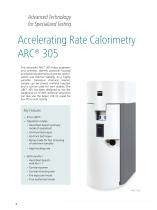
Advanced Technology for Specialized Testing The advanced ARC® 254 helps engineers and scientists identify potential hazards and tackle key elements of process optimization and thermal stability. As a highly versatile, miniature chemical reactor, sample can be stirred, material injected, and it can be used for vent studies. The ARC® 254 has been designed to use the traditional 10 ml ARC spherical vessel but can also use the larger 130 ml vessel for low Phi or vent testing. Key Features ■ RT to 500°C ■ Operation modes: • Heat-Wait-Search (primary mode of operation) ■ Iso-Fixed technique ■...
Open the catalog to page 8
Operating Modes ■ Heat-Wait-Search test for thermal runaway reactions of chemicals ■ Iso-Fixed/Iso-Track for studying storage/conditions/auto-catalytic reactions (iso-aging technique) ■ Ramp mode for screening unknown samples ■ Scanning and isothermal modes allow detection of exothermic and endothermic effects; similar to the DSC method ■ In-situ battery cycling using isothermal calorimeter mode ■ Low PHI-test with compensation Temperature tracking fast reactions can be tracked without the more reliable data and wider rate up to 200 K/min need to increase thermal inertia application range...
Open the catalog to page 9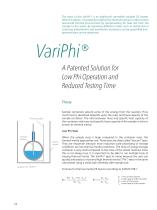
The basis of the VariPhi® is an additional controlled variable DC heater. With this option, it is possible to define the thermal inertia in order to allow real-world thermal environment by compensating for heat lost from the sample to the vessel. By operating different modes such as isothermal or scanning, endothermic and exothermic transitions can be quantified and pressure data can be measured. VariPhi® A Patented Solution for Low Phi Operation and Reduced Testing Time Theory Sample containers absorb some of the energy from the reaction. How much heat is absorbed depends upon the mass and...
Open the catalog to page 10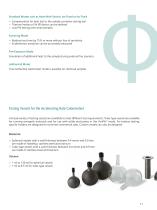
Standard Modes such as Heat-Wait-Search, Iso-Fixed or Iso-Track Compensation for heat lost to the sample container during test Thermal inertia or Phi (Φ) factor can be defined Low Phi testing with small samples Scanning Mode Reduces test time by 75% or more without loss of sensitivity Endothermic transition can be accurately measured Fire-Exposure Mode Simulation of additional heat to the sample during external fire scenario Isothermal Mode True isothermal calorimeter mode is possible on chemical samples and battery cells 3D battery sensors are available based on the VariPhi® concept. They...
Open the catalog to page 11All NETZSCH Analyzing & Testing catalogs and technical brochures
-
TG 309 Libra Series
24 Pages
-
STA 449 F5 Jupiter®
16 Pages
-
DMA 303 Eplexor
24 Pages
-
ARC® 244 ARC® 254
1 Pages
-
HMOR 422
1 Pages
-
RUL/CIC 421
1 Pages
-
Product Overview
12 Pages
-
Kinexus Prime DSR Series
20 Pages
-
DIL 402 Expedis Select/Supreme
28 Pages
-
Rosand Series
20 Pages
-
Kinexus Prime Series
20 Pages
-
Advanced Materials Testing
32 Pages
-
NTA Fire Testing Systems
20 Pages
-
NTA Guarded Hot Plate Series
16 Pages
-
Cone Calorimeter TCC 918
12 Pages
-
Photo-DSC 204 F1 Phoenix®
8 Pages
-
TMA 402 F1/F3 Hyperion®
16 Pages
-
NTA HotBoxes Test Chambers
16 Pages
-
Thermal Insulation Materials
24 Pages
-
TA-QMS Coupling
16 Pages
-
STA 2500 Regulus
12 Pages
-
SBA 458 Nemesis®
24 Pages
-
NTA HotBoxes
16 Pages
-
NETZSCH NEVIO Instrument Series
24 Pages
-
LFA 467 HyperFlash® Series
28 Pages
-
LFA 427 - product brochure
24 Pages
-
Kinetics NEO
16 Pages
-
TG-FTIR - product brochure
24 Pages
-
DMA GABO EPLEXOR up to 1500°C
12 Pages
-
DMA GABO DiPLEXOR
8 Pages
-
DIL 402 Expedis Classic
16 Pages
-
DEA 288 Ionic
20 Pages
-
GABO DiPLEXOR®
8 Pages
-
GABOMETER®
8 Pages










